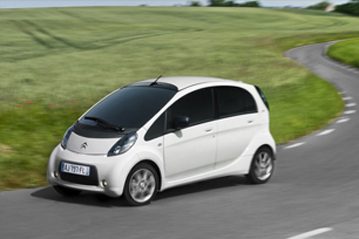
Test: Citroën C-Zero
Content
That is: no matter how many there are, and C-Zero is one of them, they are not science fiction, and this is one of their main advantages. That is: no special knowledge for management is required. You sit, you eat.
C-Zero is one of the first to open new chapters
And also some old ones that require a significant change in the minds of customers and drivers. The essential part in the name of the mentioned difference is, of course, electric drive and because of this, since it is far from a technically established thing, but a development issue, C-Zero is also very expensive. So expensive that they decided to pick it up for the rest of what is not driven to make it as cheap as possible.
Ultimately, this means that you feel like in an old, but not a second-hand car. They already had 20 years ago cars, for which we paid comparable amounts, many things that the C-Zero doesn't have - like the adjustable steering wheel and more than one light inside.
So it gets stuck in hardware
Except born electrification, Login USB, Bluetooth in system ESP (about which we will also boldly say something else), there is also nothing in this electronic mobile phone that today seems to be taken for granted in classic cars.
There is nothing better with the design and materials in the interior. Cheap plastic and very little "furniture"; the materials are pretty nicely disguised by the shape and surface, but the interior looks shabby from any distance. The next thing that attracts attention at the same time is its width. C-Zero is narrow, a bit real, but partly because of its considerable height. And the width of the wheels is the same as that of Stoenka.
But for those who can put up with the look, the above (well, the width is definitely there) can also be an advantage: if small internal width no problem, then the C-Zero is the best car for all standard parking lots that are built in parallel: they are easy to get into because there is enough space, but also because there are four side doors, and again not only because of the number of doors , but also because at the same time these doors are short (a two-door would be much longer), which again means that in practice you open them wide in front of the mall. And voila, go to him. But outside of that. From this point of view, then C-Zero is a typical city car... From thrust too (and for a well-known and rather simple reason) because of the range.
But it happens like this: there are a lot of accelerations and decelerations in the city, and in the latter, the drive batteries are at least partially charged. Driving at a constant speed of over 80 kilometers per hour depletes the batteries and brings us back to the journeys we take with a classic car today without any worries about 200 years ago.
You will travel from Ljubljana to Vienna (for example) for about the same as your days. Dr. F. Prešeren but the prince Clemens Wenzel Nepomuk Lothar von Metternich-Winneburg zu Bailstein: Like the horses of the day, today's electric car needs to eat and rest all night.
Something special behind the wheel
Ker no engine grumblingThe driver can no longer rely on noise for intuitive dosing of city speed (but of course there is no cruise control), which means more frequent glances at the sensor. At speeds above 80 kilometers per hour, of course, a gust of wind blows, not nearly as pleasant as the noise of a gasoline engine.
And back to where driving is all about accelerating and decelerating. Thus, in the latter case, the batteries are charged, which feels like much more intense braking than when braking a gasoline engine with the gas removed. This again means that during normal driving, when there is less braking, the C-Zero can no longer drive with the accelerator pedal lowered or lowered much later.
This takes some getting used to, because when you look at classic cars, this behavior is extremely unusual and is something completely different, new. In addition, driving style also has a significant impact on the volatility of data range: The more uneven the movement (acceleration and deceleration), the more the range data fluctuates.
However, it is true: judging by the arrow showing the economy of driving, the engine is very economical at city speeds.
And about the possibilities!
Electronic drive guilty of leaving C-Zero with low and medium speed almost like a good sports car... Really surprisingly good! However, the control electronics are tuned for smoother acceleration from the ground. Very tender.
But this is also understandable: the engine and rear-wheel drive, the decision of the time, can behave like a pendulum. Even with this on ESP system on slippery (asphalt) road surfaces it is often a little uncomfortable, and then the ESP has a lot of work to do. So much so that this car must have this stability program, otherwise, in the event of any adverse weather conditions, such self-propelled guns will be collected at the end of slippery turns on the other side of the ditch.
And charging?
If you have a home with a garage or power outlet next to a company car park, no problem. But if you live in an apartment building, forget about it. Conventional 10 Amp Outlets Too Few, there must be at least 15 of them.
In addition, the charging cable is large (together with the rectifier it has negligible dimensions), heavy and inconvenient. Now imagine the winter, when the cable is harder, and the closed window or door of the apartment by minus 10 degrees, and the extension cord 50 meters long, and the discontent of the neighbors ...
Which opens up new questions: we know that the battery capacity drops sharply below zero, but how much in this case? And heating: in this car you will always be cold, because pressing a button (electric, of course, because an electronic engine has no internal combustion, so there is no excess heat) instantly reduces the range by a third, even at high temperatures. above zero.
So you need to know: C-Zero, for now still pioneer among electric vehicles, is a small city car with a fairly large range, amazing performance and a lot of space, but with little equipment and some unresolved problems in everyday use.
That is why I say that now is a new world that requires a change in the minds of customers, drivers and users.
Vinko Kernc, photo: Aleš Pavletič
Citroen C-Zero
Basic data
Technical information
| engine: | Electric motor: permanent magnet synchronous motor - rear, center, transverse - maximum power 49 kW (64 hp) at 2.500-8.000 rpm - maximum torque 180 Nm at 0-2.000 rpm. Battery: lithium-ion batteries - nominal voltage 330 V - power 16 kW. |
|---|---|
| Energy transfer: | gearbox - engine drives the rear wheels - front tires 145/65/SR 15, rear 175/55/SR 15 (Dunlop Ena Save 20/30). |
| Capacity: | top speed 130 km / h - acceleration 0-100 km / h 15,9 - range (NEDC) 150 km, CO2 emissions 0 g / km. |
| Transportation and suspension: | limousine - 5 doors, 4 seats - self-supporting body - front single suspension, spring legs, double wishbones, stabilizer - De Dionova rear axle, Panhard rod, coil springs, telescopic shock absorbers - front disc brakes (forced cooling), rear disc - circle raid 9 m. |
| Mass: | empty vehicle 1.120 kg - permissible gross weight 1.450 kg. |
| Box: | The spaciousness of the bed, measured from AM with a standard set of 5 Samsonite scoops (scanty 278,5 liters): 4 places: 1 × backpack (20 l); 1 × air suitcase (36L) |
Our measurements
| T = 7 ° C / p = 992 mbar / rel. vl. = 71% / Mileage condition: 5.121 km | |
| Acceleration 0-100km: | 14,5s |
|---|---|
| 402m from the city: | 19,7 years ( 117 km / h) |
| Maximum speed: | 132km / h (D) |
| Braking distance at 100 km / h: | 41,9m |
| AM table: | 42m |
We praise and reproach
move forward
ease of use in urban environments
riding circle
flexibility from 30 to 80 kilometers per hour
Ease of Management
insensitivity of driving to cold (engine heating is not required, as in the Ministry of Internal Affairs)
backward interior
meager equipment
road position (no ESP)
on-board computer button on the sensors
range (impossible suburban routes)
impractical charging (time, infrastructure)

